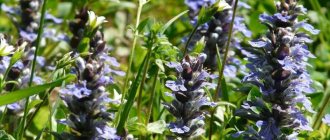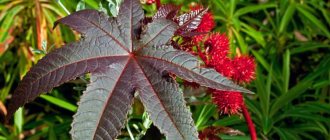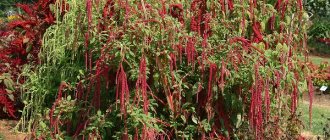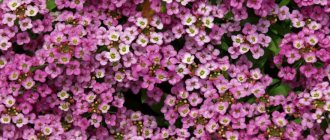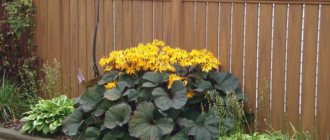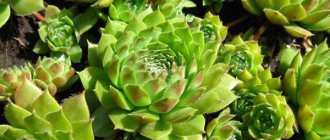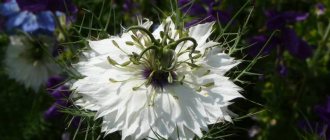Euonymus (Euonymus) belongs to the euonymus family (Celastraceae). This extensive genus includes more than 120 species, distributed in Europe, Asia, Australia and America. In nature, euonymus grows in valleys and floodplains of rivers, as well as in the undergrowth of mixed forests. Flowering of shrubs begins in late spring, simultaneously with the blossoming of leaves. Small, completely inconspicuous flowers are yellow, greenish-white, cream and dark burgundy. They smell unpleasant and are pollinated by insects. The euonymus has unusual poisonous fruits with brightly colored shoots. Leaf arrangement is opposite.
| Euonymus Fortune Canadale Gold |
In addition to deciduous tall euonymus, low evergreen shrubs are also known, characterized by weaker winter hardiness. Many graceful species of this group are suitable for planting among stones in rockeries and rock gardens.
Euonymus dwarf (Euonymus nana) grows naturally from Europe to Western China, including the mountainous regions of Western Ukraine, Moldova, Crimea, the Caucasus and Mongolia. This is an evergreen shrub about 30 m high with narrow leathery leaves 3-4 cm long. The shoots are green and greenish-gray, with longitudinal grooves. The flowers are small, 5-7 mm in diameter, with 4 greenish-brown petals, appear in June. In autumn, pink 4-lobed pear-shaped boxes are formed, but in our region the shrub bears fruit extremely rarely.
|
|
The species has been known in cultivation since 1830. It is planted under a sparse canopy of trees in small groups and is used for landscaping purposes in England. Although it is thermophilic, it persists in the ancient parks of the Moscow region, growing through the rooting of creeping shoots and escaping under the snow in winter.
Koopmann's euonymus (Euonymus koopmannii) is very similar to the dwarf euonymus, its height is no more than 1 m. This species occurs in the mountainous regions of Central Asia (Tian Shan and Pamir-Altai). The shoots are the same, green, ribbed, mostly lodging and spreading by rooting. Ascending shoots with narrow-lanceolate or linear-lanceolate leaves 1.5-5 cm long. The leaves are shiny, leathery above, bluish below. Greenish flowers about 5 mm in diameter sit singly or are collected in semi-umbrellas of 2-3 pieces. Four-lobed bolls do not form in our zone. The species has been known in culture since 1883; it is used in America, England and Germany; it is very rare in Russia.
Japanese euonymus (Euonymus japonica) comes from China and Japan, where the height of the evergreen shrub reaches 6-8 m. The greenish-brown shoots are tetrahedral in cross section. The leaves are obovate, 2-7 cm long, with a rounded tip and wedge-shaped base. Greenish-white flowers with a diameter of 5-8 mm with 4 petals, collected in umbellate inflorescences. The fruits are four-locular capsules with pink-orange buds, but in our conditions they do not always set.
The species has been in cultivation since 1804. Decorative foliage forms are known:
|
|
- Aureo-Variegata (Aureo-Variegata) with yellow-spotted leaves;
- Argenteo-Variegata (Argenteo-Variegata) with white-spotted leaves;
- Albo-Marginata (Albo-Marginata) with white edges on the leaves;
- Aureo-Marginata (Aureo-Marginata) with golden leaf edges;
- Macrophylla (Macrophylla) with larger leaves up to 7 cm long;
- Compacta (Compact) is distinguished by its compact crown and small size;
- Pyramidata (Pyramidata) with a pyramidal growth habit and broadly elliptical leaves.
Due to low winter hardiness in Central Russia, it can only survive under snow, so it grows as a low-growing shrub about 1 m high. Conditions are more favorable for it in the south of Russia, in the Crimea, in the Caucasus, in Moldova, in the southern regions of Belarus and Ukraine.
Fortune's euonymus (Euonymus fortunei) is native to China. It is closely related to the Japanese euonymus. This is a small evergreen shrub 20-40 cm high with creeping shoots covered with elliptical or oblong-ovate dense shiny leaves. The appearance of small greenish flowers in Moscow is observed occasionally, and fruiting practically never occurs.
The species has been known in cultivation since 1907. Among evergreen euonymus, its variegated varieties are most often brought to Russia from European nurseries. The following are especially popular:
|
|
- Emerald Gaiety (Emerald Gaeti) - a variety with an uneven white border on dark green leaves;
- Canadale Gold (Canadale Gold) - a compact bush with shiny yellow-edged leaves;
- Silver Queen (Silver Queen) - a compact variety with creamy young leaves, adult leaves with a wide cream stripe along the edge, flowering is noted in some years;
|
|
Euonymus Fortune Sunspot in KyivEmerald'n Gold (Emerald Gold) - a bush 40 cm high, elliptical leaves up to 3 cm long, their middle is marbled or gray-green, and along the edge there is a light yellow or lemon yellow border 2-4 cm wide, yellow leaves in spring , and in the fall they turn bright pink;
- Blondy - a variegated variety, a bush 40-50 cm high, in the middle of the leaf there is a large yellowish-white spot, in autumn the leaves are pink-red;
- Sunspot - in the middle of the elliptical leathery leaves there is an uneven wide yellow stripe, the edges of the leaves are dark green;
- Harlequin (Harlequin) - a new variety with large white spots on the leaves;
- Vegetus (Vegetus) is a profusely flowering variety with powerful shoots and large leaves, all young leaves and shoots are white.
- Kewensis (Kevensis) - an elegant variety with small dark green leaves;
- Dart's Blanket - a variety whose dark green leaves turn bronze by autumn;
- Coloratus has bright green leaves in spring and summer and purple leaves in autumn.
|
But, unfortunately, many of these varieties do not bloom and do not tolerate the climate of Central Russia.
What is euonymus and what does it look like?
The Euonymus family has 100 genera. One of them - euonymus (euonymus) - is represented by deciduous or evergreen trees and shrubs. Wild representatives of the crop can be found in mixed and deciduous forests. Through selection, hybrid varieties have been obtained that are actively used in horticulture.
Euonymus in a hedge
Euonymus shoots are round or tetrahedral. Sometimes they have corky growths on the branches. The leaves are located opposite on the shoots. In autumn, the color of green foliage in many types of crops changes to crimson-red. The flowers of the plant are inconspicuous, collected in a raceme or corymb inflorescence. 4-5 greenish or brown petals are framed by the same number of sepals.
The culture is notable for the decorativeness of its fruits - four-part capsules. In summer they are pale and unsightly, and in autumn they turn red in all shades: from pink to burgundy and dark purple. Bright garlands of euonymus fruits appear even before the green foliage changes color. A little later, the boxes open and several seeds, covered with orange or pink arils, hang from them on “legs”.
Euonymus fruits
Are the fruits of the euonymus edible?
Although euonymus fruit pods have medicinal properties, they are poisonous to humans due to their high alkaloid content. This does not prevent birds from eating fruits during the cold season. It is better to care for the plant with rubber gloves, after which you need to wash your hands with soap.
Lighting
Although pseudolaurel is shade-tolerant, it prefers bright but diffused light.
It is optimal to choose a southeast or southwest window for the euonymus . A small amount of direct sunlight, especially in winter, will not harm.
Due to insufficient lighting, the leaves of the plant may begin to turn yellow. Variegated varieties especially need bright light, since otherwise the color of the foliage becomes dull and may disappear altogether.
Types and varieties of plants
Euonymus has more than 200 species, but only about 20 grow in the climate of central Russia. Among them are deciduous, evergreen trees and shrubs. Common types of euonymus found in gardens:
- Euonymus fortunei. Fortune Emerald Gold is an evergreen shrub 40-60 cm high, native to China. The name translates as “emerald in gold” because of the decorative leaves. In the center they are green with white veins, and along the edge they are framed with a golden-yellow border. In winter, the color of some leaves changes to burgundy. Pink fruits have been decorating the bush since September. The frost-resistant plant can withstand temperatures down to -25°C. Fortune grows slowly, but is completely unpretentious.
Euonymus fortunei Fortune Emerald Gold
- Euonymus alatus compactus (winged). The homeland of deciduous shrubs is the Far East. Corky growths up to 0.5 cm form on the branches. In autumn, the foliage turns bright red. When it falls, the bushes are still decorated with burgundy fruit boxes for a long time. The shade-tolerant plant does not require special care and reproduces easily.
Euonymus alatus compactus (winged)
- Euonymus japonicus (Japanese). The name of the species speaks about its origin. A plant 50 cm high dies at temperatures below + 5°C, so it is grown in open ground only in the southern regions. The species is cultivated as a houseplant. The shrub grows well in partial shade. It can winter in a room with a temperature no higher than + 8°C. Green leaves with yellow edges are pointed at the ends. The plant blooms in late spring. Flowers and fruits are inconspicuous.
Euonymus japonicus (Japanese)
- Euonymus nanus (dwarf). Semi-evergreen shrub 0.5-1 m high. The natural habitat of the crop is the Central Caucasus. Vegetative shoots spread, fruiting shoots grow vertically. The leaves are linear-oblong with small teeth along the edges. They are bright green above and bluish below. The euonymus bush blooms in June, and pink fruits appear in September. The plant does not tolerate frost and requires winter storage in a room with a temperature of + 5-10°C.
Euonymus nanus (dwarf)
- Euonymus verrucosus (warty). The deciduous shrub, 1.5 m high, is unpretentious in care and frost-resistant, so it is grown in open ground in central Russia. Thickenings called warts form on the branches. The green leaves are ovoid in shape and finely serrated at the edges. The flowers are yellowish and inconspicuous. The fruits are capsules of dark pink color, the arils are bright red.
Euonymus verrucosus (warty)
- Euonymus europaeus (European). The species is represented by shrubs and trees. The natural habitat of the culture is Western and Central Europe. The species is characterized by yellowish wood with corky growths, yellowish-green inconspicuous flowers, pink-red fruits and orange shoots. Green foliage changes color to purple in autumn. The plant is drought-resistant and can withstand frosts down to -15°C.
Euonymus europaeus (European)
general information
Among hundreds of species there are evergreen and deciduous. There are completely dwarf creeping varieties, and there are tall giants. Most of them are heat-loving, but some are still able to withstand severe frosts.
The tallest and most spreading trees stretch up to 10 m. Most often, bushes up to 3-5 cm in diameter are found, and species up to 1.5-2 m are considered miniature. Creeping varieties are classified separately. By the way, they are good for green hedges and arches.
Euonymus is a flowering plant that blooms towards the end of spring. Its buds are not very noticeable, unlike the colorful leaves, which by autumn collect all shades from yellow to purple. In addition, long earrings, which also gradually change shade, look unusual. Keep in mind that euonymus is a poisonous plant.
Photo: sadogorod25.ru
When and how to plant euonymus
The best time to plant euonymus in open ground is the beginning of spring, although autumn planting is also acceptable. Most species grow more readily in partial shade, next to trees with a large crown. Many varieties grow quickly due to the rooting of lower shoots, so they are planted away from fences (buildings) for ease of caring for the bushes. The culture is not suitable for low-lying areas with heavy soil, where water stagnates after rain.
Soil preparation
Preparing the soil for planting euonymus
To ensure that caring for euonymus in open ground does not cause trouble, it must be planted in fertile, loose soil. Permissible soil acidity is pH 6.6-7.5. Check the acidity level of the soil using litmus paper (sold in an agricultural store).
Acidic soil is alkalized by adding lime (0.2-0.5 kg/sq. m). Alkaline soil is acidified with gypsum (2-3 kg/10 sq. m). To improve the composition of heavy clay soil, it is dug up with a mixture of humus, sawdust and sand, taken in equal proportions (1 bucket per 1 sq. m).
Euonymus seedlings in pots before planting
Planting seedlings in open ground
A three-year-old euonymus seedling easily takes root in open ground. Planting crop shoots younger than 3 years old requires painstaking care. Algorithm for planting euonymus in open ground:
- You can plant shoots when the air temperature in spring does not drop below 5 degrees Celsius during the day.
- Dig holes at a distance of 0.7-1.5 m from each other. The volume of the hole should be 2 times greater than the root system of the seedling.
- Fill ¼ of the recess with a drainage layer (expanded clay, broken brick or crushed stone).
- Prepare the soil mixture: mix turf soil with leaf soil, humus (compost) and sand (ratio 3:1:1:1).
- Pour 10 cm of prepared soil on top of the drainage, place the seedling in the center, straighten the roots.
- Fill the hole to the top with soil, gently press it down with your hands to stabilize the shoot, and water it generously.
- When the soil settles, add soil and mulch (with sawdust, straw, sunflower husks, etc.).
- 2 weeks after planting, water the seedlings moderately when the top layer of soil dries 5-7 cm.
Transfer
Euonymus is transplanted annually in the spring, in March-April, into a larger pot, since its root system grows very quickly.
When transplanting euonymus, the roots can be trimmed a little.
Plants that are more than 5 years old are replanted every 2-4 years when the pot becomes too small. It is recommended to update the top layer of soil annually.
You can read more about plant transplantation here.
Often adult plants are replanted every 5 or even 6 years. This is possible when the root system has slowed down its growth sufficiently and the flower pot does not become cramped for a long time. At the same time, euonymus grows for years in the same soil without suffering from lack of nutrition.
Regular feeding is enough for the growth and development of the plant. Therefore, adult and old specimens are replanted only when absolutely necessary, when the roots no longer fit in the pot.
Watering and care features
Most types of euonymus are drought-resistant crops. Bushes should be watered sparingly only in dry summers. The earthen clod should not be allowed to dry out too much, nor should it be over-moistened. When water stagnates in the soil, the roots begin to rot, which can cause the plant to die. To make moisture evaporate more slowly from the surface of the earth, mulch the root circle. This prevents weeds from growing around the bush.
Watering euonymus
With the onset of cold weather, the soil around the plant is dug up along with mulch. The surface of the earth under the crown is covered with a 10 cm layer of peat and humus (1:1). Organic matter protects the roots from freezing and at the same time nourishes them. Mature trees and shrubs of regional varieties do not need shelter for the winter.
Seedlings under 3 years old that overwinter without insulation will die. In the fall, fallen leaves and old mulch are removed with a rake around the bushes. With the onset of the first frost:
- The root zone is covered with a 10 cm layer of peat with sawdust (1:1).
- The stems are covered with spruce branches on all sides.
- The structure is wrapped on top with agrofibre, folded in three.
- They tie the bush with twine.
- When snow falls, the shelter is covered with a snowdrift of at least 30-50 cm.
Humidity
Since euonymus has leathery leaves that evaporate little moisture, it can easily adapt to the dry air of apartments. However, very low humidity combined with high temperatures can cause the flower to begin to shed its leaves. Peudolaurus grows best when the ambient humidity is above 50%.
To increase the humidity level, you can place containers of water around the plant, and during the heating season, place a damp cloth on the radiators.
Shrub pruning
Pruning euonymus
Caring for euonymus in open ground includes annual pruning in spring and summer. After wintering, frost-damaged shoots and dead wood are removed and a crown of the desired shape is formed. Summer pruning is carried out to maintain the decorative appearance of the bush - weak and overly elongated shoots are pruned. The crown of single bushes is often formed in the form of a ball, cone or pyramid. Border plantings and hedges made of euonymus are trimmed in the shape of rectangles.
Cultivation
Due to its high decorative value, Forshuna birch is used in various ways in landscape design. Here are just a few of the possibilities:
- Heather, Japanese gardens;
- Decoration of artificial reservoirs;
- mixborders;
- alpine mountain gardens;
- lawns;
- Coniferous compositions;
- single landings;
- If grown as a shrub rather than a ground cover, Birchwood Fortune will work well as a hedge.
- Decor for garden structures (pergolas, trellises) and furniture (benches);
- borders and parterres;
- Vertical gardening;
- Stony Gardens;
Another important characteristic of Forshun birch is that it tolerates dirty, polluted air and dust well. Therefore, it is often used in urban landscapes of local areas, in park compositions, and squares.
Fertilizing and feeding euonymus
If the necessary fertilizers were applied when planting shoots in open ground, fertilizing of the bushes begins after 3 years. It is better to apply fertilizers in May and September. In spring, slurry is prepared:
- cow (horse) manure is poured with water 1:10, bird droppings - 1:20;
- leave the solution for 10 days to ferment;
- Before watering, the concentrate is diluted with water 1:10.
Water the euonymus with slurry at the rate of 10 liters per bush. Instead of organic matter, you can feed the plant in the spring with nitrogen mineral fertilizer (50 g of urea per bucket of water). This will promote rapid growth of green mass.
In the summer, for the active formation of beautiful fruit boxes, potassium-phosphorus fertilizers are applied (40 g of potassium sulfate and double superphosphate per 10 liters of water). Autumn digging of the ground under the bush with 300 g of slaked lime will bring the soil prone to acidification back to normal.
Problems
- The main reason why a plant's leaves turn yellow and fall off is overwatering;
- The leaves become dull, turn pale, and begin to curl when exposed to excess light;
- Euonymus leaves begin to fall off when humidity is low and temperatures are high in winter;
- Variegated species lose their bright colors due to lack of light.
Another reason for the loss of color in variegated varieties is excessive feeding of the plant with nitrogen fertilizers. It is necessary to feed the euonymus no more than once a month.
The leaves of the plant turn yellow and dry out when the earthen clod dries out for a long time. It is recommended to water regularly.
The plant significantly slows down its growth and begins to lose leaves en masse in a very cramped pot. At the same time, it is recommended to transplant it into a pot whose diameter is 1-2 cm larger.
How does euonymus reproduce?
Euonymus seedlings
There are 5 options for propagating euonymus. The choice depends on the type of crop and the experience of the gardener. Methods for obtaining eonimus seedlings:
- Seeds. The most difficult way. The seeds are collected before the fruit capsules crack. They are cleared of pulp and treated in a 1% solution of potassium permanganate (1 g/100 ml of water). Embed into the soil of temporary containers to a depth of 2 cm. In winter, seedlings are kept indoors at a temperature of 8-10°C. For spring planting, the treated seeds are subjected to stratification (kept for 3-4 months in the basement at a temperature of 10-12°C), and then stored until spring in the refrigerator on the bottom shelf, wrapped in polyethylene.
- By layering. Some types of euonymus have vegetative shoots that spread along the ground and take root independently near the bush. More planting material can be obtained if the lower branches are attached to the soil with wire in the spring. In autumn, rooted shoots are pruned from the mother bush and planted in temporary containers for growing up to 3 years of age. If winters in the region are warm, the sprouts are planted in open ground in a permanent place.
- Cuttings. A labor-intensive method of propagation, but with the help of it a lot of planting material is obtained. Propagation by cuttings is carried out at the end of June. The apical shoots of plants older than 5 years are cut. The petiole should be 7 cm long and have 1 internode. The cuttings are planted in fertile soil under a film. The soil needs to be mulched with 5-7 cm of sand to retain moisture. Care consists of constantly moistening the bed. Rooting occurs in 1.5 months.
- Root suckers. In early spring, young shoots under the bush along with the rhizome are cut off with the tip of a shovel. Shoots with roots 20-30 cm long and 1.5 cm thick take root well. The optimal shoot height is 40-50 cm. Tall stems are trimmed to the required size to make it easier for the plant to provide them with nutrients. The offspring are planted immediately in a permanent place of growth.
- Dividing the bush. Suitable for dwarf crop species. Bushes older than 5 years are divided into parts with a healthy root system and 5-7 stems. There must be at least 1 growth bud on the root neck. The branches of the divisions need to be shortened by 2/3 and planted in a permanent place. Care in the first 2 weeks is the same as for 3-year-old seedlings.
Pinning a vegetative shoot of euonymus to the ground
Spraying
Spraying is especially important on hot days
Euonymus responds well to spraying, which is recommended 2-3 times a week, in the morning or evening. The procedure is especially important on hot summer days and during the heating season, when the indoor air becomes very dry.
For spraying, it is important to use filtered or boiled water so that there are no traces or plaque left on the leaves.
It is periodically recommended to give the euonymus a warm shower . It helps to achieve two goals: the first is to clean the bush from dirt and dust, the second is that the shower prevents the appearance of pests.
Pest and disease control
In open ground, caring for euonymus includes measures to prevent and combat diseases and plant pests. Trunk rot is a disease caused by putrefactive bacteria. It is very difficult to cure a diseased bush. Prevention of the disease is proper watering of the crop. To prevent the disease, the plant is treated with 1% Bordeaux mixture in the spring (before the leaves bloom) and after leaf fall.
Method for preparing the anti-rot remedy:
- Pour 100 g of copper sulfate into one container and pour in 5 liters of water, stirring constantly. Use only plastic containers!
- In another container, similarly combine 100 g of lime with water.
- Pour the vitriol solution into the milk of lime in a thin stream, while stirring the contents.
Euonymus Pests
Powdery mildew disease is caused by a pathogenic fungus that can spread to euonymus from other garden crops. The plant can be cured by spraying it with 1% Bordeaux mixture or a fungicide such as Tiovit Jet (50 g per 10 liters of water). If necessary, the procedure is repeated after 2 weeks.
Main crop pests and ways to combat them:
- Shield. Dark plaques appear on the leaves and stems, under which the insect hides. The shield protects the pest from negative influences, so spraying with an insecticide will not bring results. You need to dissolve 1-2 ml of a chemical like Aktara in 1 liter of water, add 2 tbsp. spoons of liquid soap. Using a sponge, manually process the plant, mechanically removing the shields (work with gloves). After half an hour, rinse off the product with water from a spray hose.
- Apple moth. Spider nests appear on the stems, containing pest caterpillars that devour the leaves. Affected branches should be cut and burned. Treat the plant with the Fitoverm insecticide (2 ml/1 l of water). Solution consumption – 1 liter per adult bush.
- Hawthorn. Caterpillars (4-5 cm) of a large white butterfly with black lines on the wings eat the leaves of the plant. They are destroyed in the same way as the apple moth.
- Aphid. Tiny green or black insects settle on the back of the leaves and lay eggs there. They feed on plant juice. The parasite multiplies very quickly. The leaves curl and become covered with a sticky liquid secreted by insects. They get rid of aphids with an insecticide like Actellik. 2 ml of the drug is diluted in 1 liter of water. To treat 10 m² of plantings, 1.5 liters of chemical solution is required.
- Red flat tick. The leaves become covered with discolored spots, which then turn into bubbly tubercles. To combat the pest, tear off the infected foliage and burn it. After this, treat the bush with the Kleschevit insecticide (2 ml / 1 l of water). Consumption – 1 liter of solution per adult bush.
- Spider mite. The leaves wither and fall off. A web appears on the shoots, in which the pest hides. To destroy the parasite, use Kleschevit (described above).
general description
The plant of the euonymus genus is a winter-hardy ornamental shrub or low tree. The genus contains deciduous and evergreen varieties, on the shoots of which, in most species, coarse growths form with age.
The plant is characterized by slow development, giving no more than 10-12 cm of annual growth. But the euonymus can live in the garden for up to 50 years or longer, the first 15 of which it will grow. At a more mature age, his energy will be spent on maintaining the crown and replacing non-viable shoots with young ones.
Important! The plant is poisonous and contains alkaloids; its fruits should not be eaten, and you need to wear gloves when handling it!
Euonymus in landscape design
Euonymus on a summer cottage
Landscape design option with euonymus
Option for planting euonymus in the country
Location, light requirements
The choice of location depends on the selected species. If the area is open to the sun, it is better to give preference to Maak's euonymus. The European or warty species thrives in partial shade or even shade among sparsely planted large trees. And yet, where the sun practically does not look at all, the winged or Sakhalin euonymus will feel best. They are also best to choose when planting on a slope, since they grow well and over time root the lower shoots, delaying landslides.
A lack of light for shrubs with poor shade tolerance will lead to the growth of a thin and shapeless crown, which will significantly lose in decorativeness.
